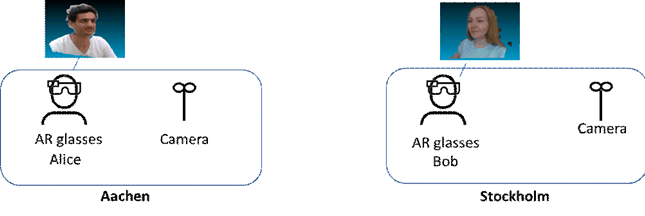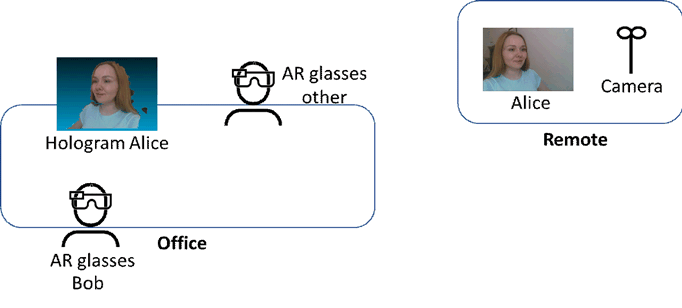Content for TR 26.998 Word version: 18.0.0
0…
4…
4.2…
4.2.2…
4.2.2.2
4.2.2.3
4.2.2.4
4.2.3…
4.3…
4.4…
4.5…
4.6…
4.6.4…
4.6.5…
4.6.8…
5
6…
6.2…
6.2.4…
6.2.4.2
6.2.5…
6.3…
6.3.4…
6.3.4.2
6.3.5…
6.4…
6.4.4
6.4.5…
6.5…
6.5.4
6.5.5
6.5.6…
6.6…
6.6.4
6.6.5…
7…
8…
8.9
9
A…
A.2
A.3…
A.4
A.5
A.6
A.7…
A.4 Use Case 19: AR Conferencing p. 113
| Use Case Description: AR Conferencing |
|---|
This clause describes an AR conferencing use-case that allows participants in a 3D volumetric representation, e.g. point clouds or meshes, in order to provide an immersive conferencing experience.
AR Conferencing (1:1)

AR Conferencing (1:many)

|
| Categorization |
|
Type:
AR
Degrees of Freedom:
3DoF+ or 6DoF
Delivery:
Conversational
Device:
AR glasses
|
| Preconditions |
|
| Requirements and QoS/QoE Considerations |
The network is required support the delivery of 3D volumetric streams for real-time conversational services:
|
| Feasibility |
The bandwidth and latency requirements for AR conferencing using 3D volumetric representations present a challenge to mobile networks. The complexity of the 3D volumetric representations is challenging for the endpoints and introduces additional delay for processing and rendering functions. Intermediate edge or cloud components are needed.
In the following some indicative values of potential solution and transmission format for different types of user representation:
|
| Potential Standardization Status and Needs |
The following aspects may require standardization work:
|